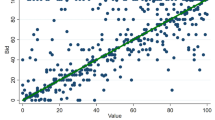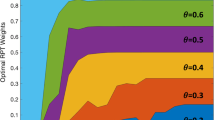Abstract
Bilateral trade problem is the most common market interaction in which a seller and a buyer bargain over an indivisible object, and the valuation of each agent about the object is private information. We investigate the cases where mechanisms satisfying Dominant Strategy Incentive Compatibility (DIC) and Ex-post Individual Rationality (EIR) properties can exhibit robust performance in the face of imprecision in prior structure. We start with the general mathematical formulation for the bilateral trade problem with DIC, EIR properties. We derive necessary and sufficient conditions for DIC, EIR mechanisms to be Ex-post efficient at the same time. Then, we define a new property—Allocation Maximality—and prove that the Posted Price mechanisms are the only mechanisms that satisfy DIC, EIR and Allocation Maximal properties. We also show that Posted Price mechanism is not the only mechanism that satisfies DIC and EIR properties. The last part of the paper introduces different sets of priors for agents’ types and consequently allows ambiguity in the problem framework. We derive robust counterparts and solve them numerically for the proposed objective function under box and \(\phi \)-divergence ambiguity specifications. Results suggest that restricting the feasible set to Posted Price mechanisms can decrease the objective value to different extents depending on the uncertainty set.




Similar content being viewed by others
Notes
The assumption that each state of the world is an independent draw from a commonly known distribution is called common prior assumption.
The buyer gets the object if and only if the buyer’s valuation is higher than the seller’s.
We work with more general discrete type sets in Proposition 1. However, we prefer the simple type set \(T\) not to encumber the notation.
In the Posted Price mechanism, the price of trade is posted by the planner and the agents trade at that price or do not trade at all.
References
Bayrak HI, Pınar MÇ (2016) Generalized second price auction is optimal for discrete types. Econ Lett 141:35–38
Bayrak HI, Güler K, Pınar MÇ (2017) Optimal allocation with costly inspection and discrete types under ambiguity. Optim Methods Softw 32(4):699–718
Bayraksan G, Love DK (2015) Data-driven stochastic programming using phi-divergences. In: The operations research revolution, INFORMS, pp 1–19
Ben-Tal A, Bertsimas D, Brown DB (2010) A soft robust model for optimization under ambiguity. Oper Res 58(4–part–2):1220–1234
Ben-Tal A, Den Hertog D, De Waegenaere A, Melenberg B, Rennen G (2013) Robust solutions of optimization problems affected by uncertain probabilities. Manag Sci 59(2):341–357
Bose S, Ozdenoren E, Pape A (2006) Optimal auctions with ambiguity. Theor Econ 1(4):411–438
Carroll G (2017) Information acquisition and robust trading mechanisms. Unpublished manuscript, Stanford University, Stanford
De Castro LI, Yannelis NC (2010) Ambiguity aversion solves the conflict between efficiency and incentive compatibility, Technical report, Discussion Paper. Center for Mathematical Studies in Economics and Management Science
Flesch J, Schröder M, Vermeulen AJ (2013) The bilateral trade model in a discrete setting. Department of Quantitative Economics, Maastricht University, Maastricht
Flesch J, Schröder M, Vermeulen D (2016) Implementable and ex-post IR rules in bilateral trading with discrete values. Math Soc Sci 84:68–75
Gilboa I, Schmeidler D (1989) Maxmin expected utility with non-unique prior. J Math Econ 18(2):141–153
Hagerty KM, Rogerson WP (1987) Robust trading mechanisms. J Econ Theory 42(1):94–107
Koçyiğit Ç, Bayrak HI, Pınar MÇ (2018) Robust auction design under multiple priors by linear and integer programming. Ann Oper Res 260(1–2):233–253
Kos N, Manea M (2009) Efficient trade mechanisms with discrete values, Technical report. Working paper
Kouvelis P, Yu G (2013) Robust discrete optimization and its applications, vol 14. Springer, Berlin
Matsuo T (1989) On incentive compatible, individually rational, and ex post efficient mechanisms for bilateral trading. J Econ Theory 49(1):189–194
Myerson RB, Satterthwaite MA (1983) Efficient mechanisms for bilateral trading. J Econ Theory 29(2):265–281
Othman A, Sandholm T (2009) How pervasive is the Myerson–Satterthwaite impossibility? In: IJCAI, pp 233–238
Pardo L (2005) Statistical inference based on divergence measures, vol 185. Chapman & Hall/CRC, London
Pınar MÇ (2018) Robust trade mechanisms over 0–1 polytopes. J Comb Optim 36(3):845–860
Pınar MÇ, Kızılkale C (2017) Robust screening under ambiguity. Math Program 163(1):273–299
Tawarmalani M, Sahinidis NV (2005) A polyhedral branch-and-cut approach to global optimization. Math Program 103:225–249
Vohra RV (2011) Mechanism design: a linear programming approach, vol 47. Cambridge University Press, Cambridge
Vohra RV (2012) Optimization and mechanism design. Math Program 134(1):283–303
Wächter A, Biegler LT (2006) On the implementation of an interior-point filter line-search algorithm for large-scale nonlinear programming. Math Program 106(1):25–57
Author information
Authors and Affiliations
Corresponding author
Appendix
Appendix
1.1 Proof of Proposition 1
Proof
Assume that there exists a DIC, EIR and Ex-post Efficient mechanism \((p^*,x)\) but convex hull of sets \(T_b^*\) and \(T_s^*\) have infinite intersection. Then, there exist \(b_j \in T_b^*\) and \(s_i \in T_s^*\) such that \(b_j\) is strictly less than \(s_i\). By definition of efficient type sets, there exist types \(s_l \in T_s\) and \(b_k \in T_b\) satisfying \(s_l < b_j\) and \(b_k > s_i\). Then, we can write \(s_l< b_j< s_i < b_k\) so that \(p_{lj} = p_{lk} = p_{ik} =1\) holds. We know from Lemma 1 that \(x_{lj} = x_{lk} = x_{ik}\) should also hold in order to satisfy DIC constraints. Given all this information, let us check EIR constraints. We see that \(b_j \ge x_{lj} \ge s_l\) and \(b_k \ge x_{ik} \ge s_i\) cannot be satisfied together with \(x_{lj} = x_{ik}\) since we have \(b_j < s_i\). Hence, there is no transfer rule we can use together with \(p^*\) to have a DIC, EIR mechanism. This is a contradiction.
Now we start from efficient type sets \(T_b^*\) and \(T_s^*\) whose convex hulls have finite intersection. If both efficient type sets are empty, we have a trivial case \(b_m \le s_1\) where seller always values the good more. Then, any Posted Price mechanism imposes Ex-post Efficiency. In the non-trivial case, both sets are non-empty and minimum type, \(\underline{b}\), in \(T_b^*\) should be bigger than or equal to maximum type, \(\bar{s}\), in \(T_s^*\). Here, any Posted Price mechanism with unique price \(x \in [\bar{s}, \underline{b}]\) will be Ex-post efficient. Since all Posted Price mechanisms are DIC, EIR, the proof is complete. \(\square \)
Rights and permissions
About this article
Cite this article
Kargar, K., Bayrak, H.I. & Pinar, M.Ç. Robust bilateral trade with discrete types. EURO J Comput Optim 6, 367–393 (2018). https://doi.org/10.1007/s13675-018-0106-x
Received:
Accepted:
Published:
Issue Date:
DOI: https://doi.org/10.1007/s13675-018-0106-x




